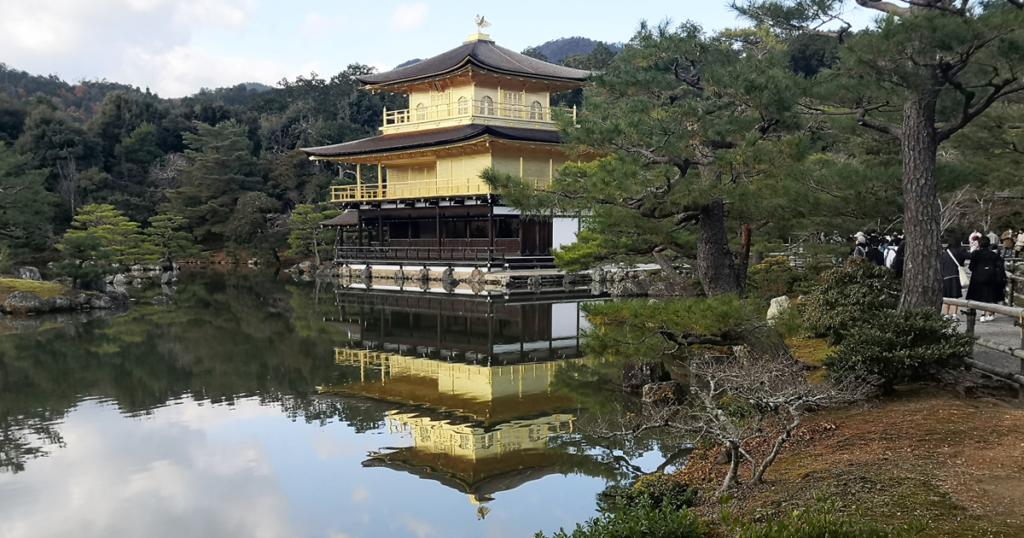Kyoto Kinkakuji / Rokuonji.
Kyoto Kinkakuji / Rokuonji.
I entered the car as directed to the large “Kinkakuji No. 1 parking lot” where large sightseeing buses also stop.
Kiyomizu-dera and Ginkaku-ji did not have their own parking lot, but Kinkaku-ji has three parking lots.
The parking fee is 300 yen/hour for cars and 100 yen/hour for motorcycles, It is so reasonable price in Kyoto.
Kinkakuji was built in 1397 at the end of the 14th century by Yoshimitsu Ashikaga, the third shogun of the Muromachi Shogunate.
However, since it was rebuilt after the 2nd world war, there is not enough time to designate it as a national treasure, so it is not designated as a national treasure in Japan.
Also, the most famous photographs of Kinkaku-ji Temple are a building that enshrines Buddha’s bones (Buddha’s ashes) called Shariden.
The mountain name of Kinkakuji/Rokuonji is Kitayama. The principal object of worship is Sho Kannon.
On December 17, 1994, it was registered as a UNESCO World Heritage Site along with Ginkakuji, Kiyomizu-dera and Nijo-jo Castle as part of the “Historic Monuments of Ancient Kyoto (Kyoto, Uji and Otsu Cities)”
[reference]UNESCO World Heritage Convention.
From the large first parking lot of Kinkakuji, pass the side of the souvenir shop and enter the approach.
After passing through the approach that looks like an orderly garden,
There is a guide board of Kinkakuji precincts,
You can see the main gate of Kinkakuji (Rokuonji).
In front of the main gate, There is a large stone monument of “World Heritage Kinkaku Rokuonji”.
Explanations about that it is a sub-temple of the Shokoku-ji denomination of the Rinzai sect, and that it was named after Yoshimitsu’s Buddhist name “Rokuon-in-den” were also written on wooden notice boards.
After going through the main gate,
There is a bell tower on the left.
Pay the worship fee at the building called “Kori” and enter.
Same as Ginkakuji, the entrance ticket is a guardian tag.
Visiting hours: 9:00-17:00
Worship fee
Adults (high school students and above): 400 yen.
Elementary and junior high school students: 300 yen.
After walking for a while on the right hand side, you can see the Rokuonji Reliquary Hall “Kinkaku” floating on Kyokochi-pound.
It is probably the scene of Kinkakuji that many people have seen.
Kyokochi-pound itself is also worth seeing as a beautiful Japanese garden.
No matter where you look at the precincts of Kinkakuji, it is very tasteful.
Reliquary hall “Kinkakuji”.
The interior of the relic hall “Kinkaku-ji” cannot be entered, but a photo of the interior is posted to introduce it.
Upper left: The third floor of Kinkaku-ji Temple.
Upper right: The second floor of Kinkaku-ji Temple.
Bottom right: The first floor of Kinkaku-ji Temple.
Bottom left: Winter view of Kinkaku-ji Temple.
After passing the Kinkaku Shariden, there is a shop that sells talismans and amulets.
Ganka sui.
Muromachi Bakufu third shogun Yoshimitsu’s restroom water.
…In other words, the water for Yoshimitsu to wash his hands after using the toilet.
Kinkakuji-gaki(fence).
carp stone.
White Snake Mound.
Sekkatei Teahouse’s A water basin shaped like Mt. Fuji.
Sekkatei Teahouse
There are also some foreign couples in kimonos here and there.
Fudogama Tea Garden.
Fudo Hall.
Dakiniten.
It’ a Buddhist god, and the original one is a kind of yasha(demon).
Kinkaku-ji has many other attractions besides the Kinkaku-shariden, and it takes a lot of time to look around Kinkaku-ji.
I think it’s good to research in advance, and it might be fun to come and research and come back and research in depth.

